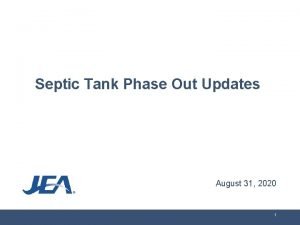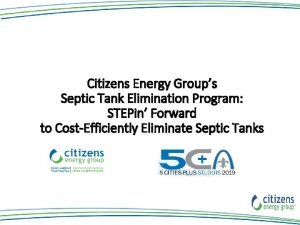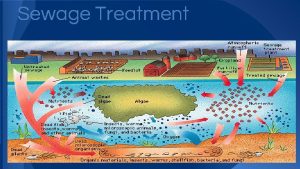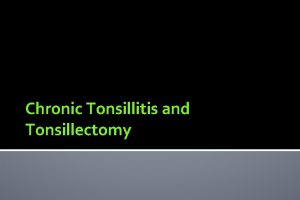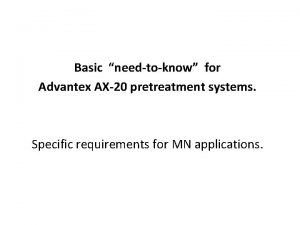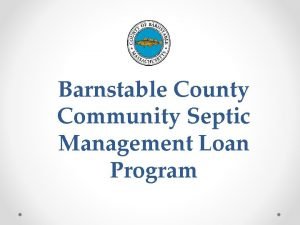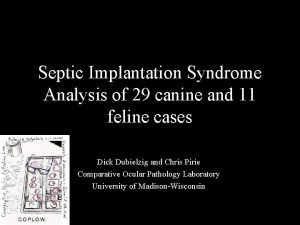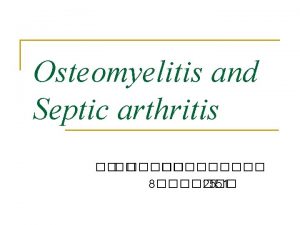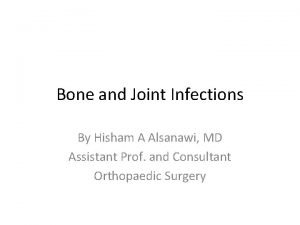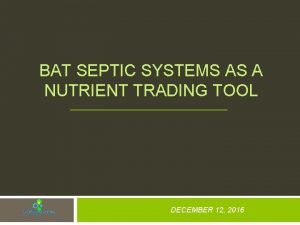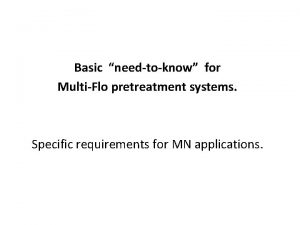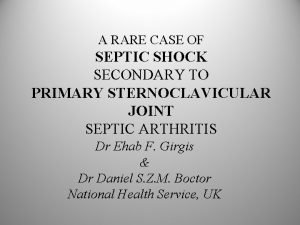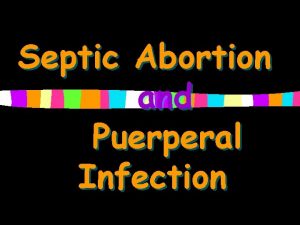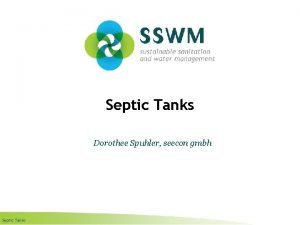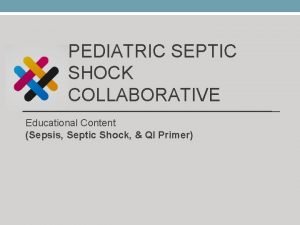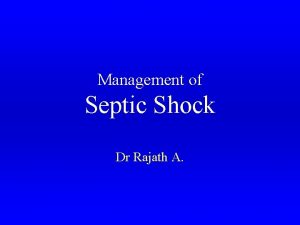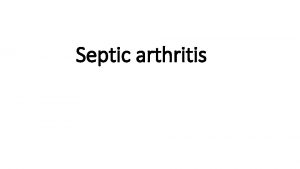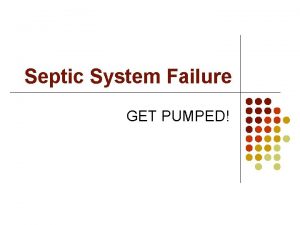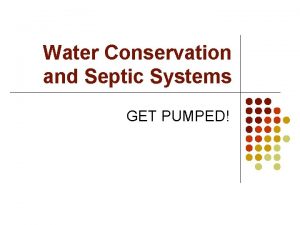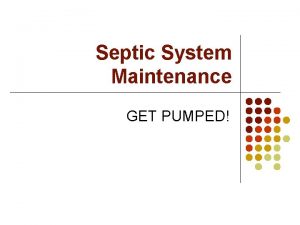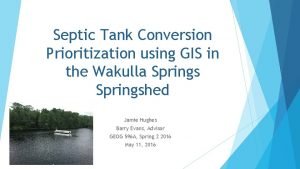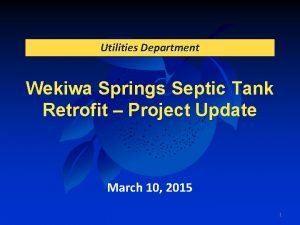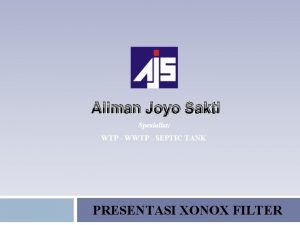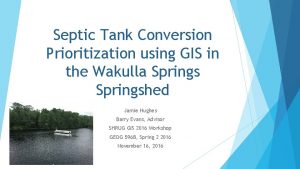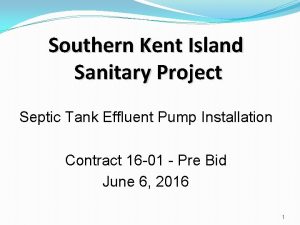Septic Tank Phase Out Updates August 31 2020





















- Slides: 21

Septic Tank Phase Out Updates August 31, 2020 1

Communities are funding the septic tank phaseout programs using various methods including grants Grants are very limited Indian River County • • Utility Reserve Funds Sales Tax Cost-share Grant Owner Portion • Water Management Districts Ø Florida Springs and Aquifer Protection Act, $50 M annually for 20 years beginning in 2016 Ø South Daytona $826 K total construction cost (District contribution $205 K) Ø City of Minneola $2. 4 M total construction cost (District contribution $778 K) FDEP Springs Funding Ø Septic Upgrade $10 K per advanced onsite system Ø Citrus, Hernando, Leon, Marion, Orange, Pasco, Seminole, Volusia and Wakulla City of Rockledge grant dollars and $1. 2 M legislative appropriation (no assessment) 2

Communities are funding the septic tank phaseout programs using various methods Non Ad-Valorem Assessment + Other Sources Ø Loxahatchee River District pays 10% of the cost, remainder is non ad-valorem assessment Ø Charlotte County pays if >$11, 500 per ERC, also has a hardship program Ø City of Cape Coral one-time assessment for all parcels plus variable fees per property based on actual costs Ø Sarasota County $1, 000 early incentive refund/credit also has received grants but majority on assessment Enterprise Funds Ø Hillsborough County, City of Hollywood 3

The Florida Dept of Health also researching cost effective advanced septic system treatment methods Onsite treatment and reuse area 4

COJ and JEA have an active septic tank phaseout (STPO) program STPO Areas Converted or In-Process 65, 000 septic systems and 35, 000 private water wells remain >$2 B In 2003 Water & Sewer Infrastructure Task Force identified Septic Tank Failure Areas 5

JEA has used a variety of funding sources for previous Septic Tank Phase-Out projects Septic Tank Phase-Out Project Funding Better Jacksonville Plan Projects Total Funding City of Jacksonville 0. 5% Sales Tax $75. 0 FDEP Grants $10. 0 Water Sewer Expansion Authority $6. 0 City of Jacksonville General Fund $2. 5 Total $93. 5 million JEA Contribution 2016 Contribution* $15. 0 2019 Contribution ** $15. 15 Total $30. 15 million *One time $15 M contribution, to be matched by COJ, as part of the 2016 5 year contribution extension ** One time $15. 15 M contribution from the Southside Generation Station property sale 6

STPO project areas are prioritized annually Environmental, Health & Welfare • Department of health score (septic system repair permits) • Proximity to St. Johns River • Water quality benefit • Fecal coliform impairment Community Considerations • • • Age of development Median home value Private water wells Undeveloped lots Economic development 7

STPO project area matrix developed with input from DOH, COJ and JEA 8

STPO Project Area Matrix Top 3 Prioritized Areas Environmental, Health & Welfare (Max. 70 points) Community Considerations (Max. 30 points) Overall Area DCHD No. of Units Factor For Lots Impaired Development Median Community Designation 2016 Within The Tributary & Welfare Prior to Home Value of Future Development Considerations Total Score Area 150 M Buffer. A 150 M Buffer Exceedance Score 1968 Proliferation Opportunities Score (60 pts)D (BMAP) Factor. C 10 pts 5 pts Water 5 pts Biltmore C 49. 00 173 135 4 0. 00 53. 00 10 5 5 2. 7 2. 0 24. 7 77. 70 Beverly Hills 60. 00 695 279 2 1. 35 63. 35 10 4 0 0. 1 0. 0 14. 1 77. 45 Christobel 49. 76 289 62 2 2. 20 53. 96 10 5 1 3. 8 2. 0 21. 8 75. 76 Environ, Health Elimination Offsite Economic 9

Current STPO Project Updates Biltmore ‘C’: Currently under construction Forecasted completion – late August 2021 Beverly Hills West: Design & permitting completed. Anticipate advertise for construction bids in early September 2020 Forecasted construction start – early March 2021 Beverly Hills Offsite Force Main: Construction bids received July 21, 2020 Forecasted Notice to Proceed – Mid-September 2020 Beverly Hills East: 60% design completed 100% design submittal due December 24, 2020 Forecasted construction start – late July 2021 Christobel: JEA Outreach and Town Hall meetings – no activity at this time Current program funding adequacy to be assessed after receipt of Beverly Hills West and East bi *Information updated 8/26/20 10

Biltmore C Costs Initial Set up and Outreach $ 247, 400 Survey & Engineering $ 1, 274, 645 CEI $ 684, 986 JEA $ 360, 618 Construction $ 16, 100, 000 TOTAL Cost per Lot $ 18, 667, 649 $ 53, 033. 09 11

In 2019, JEA sought innovations in alternatives to septic systems • Select the best wastewater management strategy solution for each STPO priority area • Recognize technological advances • Evaluate possible program cost reductions 12 12

The overarching goal of the Master Plan is to optimize the phaseout program – while recognizing realistic financial considerations Phase 1 . • Technologies Literature and Industry Best Practices Review and Screening Phase 2 • Geographical Master Conceptual Plan . . Phase 3 • Potential Pilot Testing Phase 4 . • Public Education 13

Phase 1 and Phase 2 look at: Institutional Frameworks Treatment Technologies Funding Management Strategies Master Plan 14

Master Plan work started with a literature and industry best practices review to identify possible solutions Single dwelling or building on-lot collection, treatment and disposal ONSITE Multi-source collection small-scale treatment facility DECENTRALIZED Multi-source collection large (existing JEA) treatment facility CENTRALIZED Hybrid INTEGRATED MANAGEMENT combination of above 15

Possible solutions include alternative sewer collection and transmission systems Conventional gravity sewers • Larger diameter • Deeper installation Low pressure, vacuum sewers • Smaller diameter • Shallower installation 16

Possible solutions are being screened using decision making criteria Project Area Characterization 17

Characterization of the STPO project areas will be used in screening possible solutions Ex. WW Network Rise in Sea Level YR 2060 Characterization: • Existing customers • Land Use • Existing Utilities • Topography • Environmental factors (including sea level rise) Septic System Ex. Customer 18

Criteria will be used to screen potential technical solution(s) within already prioritized STPO areas Maximize Benefits of WW Management Alternatives Cost Implement Environmental Impacts Secondary Impacts Reliability General impact to rate payers Ability to Phase Nitrogen Reduction Odor/ Aesthetic Climate Resiliency Potential for Reuse Ease of Management Construction Impacts (Env. ) Short Term Construction Impacts Potential for Disruption from Construction Breakage Public Perception Ease of Siting Regulatory Acceptance 19

Phase 1 and Phase 2 are 40% complete and projected to be finished by May 2021 Phase 1 Reporting Phase 2 Master Plan Report Completion Date 12/2020 05/2021 20

Project Timeline – major deliverables to completion 2019 10 11 2020 12 01 02 2021 03 04 05 06 07 08 09 10 11 12 01 02 03 04 05 Lit. Review Technology Screening Strategies Screening Phase 1 Reporting Project Area Characteriz. Project Area Screening Phase 2 Master Plan 21
 Jea septic tank phase out
Jea septic tank phase out Septic tank contamination groundwater
Septic tank contamination groundwater Septic systems indianapolis
Septic systems indianapolis Doc's septic tank cleaning
Doc's septic tank cleaning One direction song one thing
One direction song one thing Hypoandrogenism
Hypoandrogenism Ervin moore sign
Ervin moore sign Advantex ax20
Advantex ax20 Barnstable septic loan
Barnstable septic loan Septic implantation syndrome
Septic implantation syndrome Septic arthritis complications
Septic arthritis complications Panhandle health septic
Panhandle health septic Septic arthritis antibiotics
Septic arthritis antibiotics Septic arthritis antibiotics
Septic arthritis antibiotics Bat septic
Bat septic Multi flo aerator replacement
Multi flo aerator replacement Puraflo peat
Puraflo peat Septic arthritis complications
Septic arthritis complications Enthesitis
Enthesitis Haemophilus influenzae septic arthritis
Haemophilus influenzae septic arthritis Haemophilus influenzae
Haemophilus influenzae Example of gram negative cocci
Example of gram negative cocci
